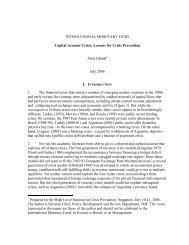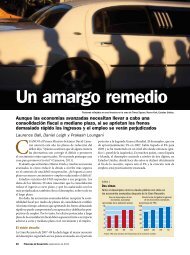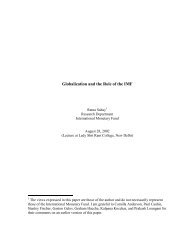Chapter 20: Taxation of Corporate Reorganizations - IMF
Chapter 20: Taxation of Corporate Reorganizations - IMF
Chapter 20: Taxation of Corporate Reorganizations - IMF
You also want an ePaper? Increase the reach of your titles
YUMPU automatically turns print PDFs into web optimized ePapers that Google loves.
Tax Law Design and Drafting (volume 2; International Monetary Fund: 1998; Victor Thuronyi, ed.)<br />
<strong>Chapter</strong> <strong>20</strong>, <strong>Taxation</strong> <strong>of</strong> <strong>Corporate</strong> <strong>Reorganizations</strong><br />
A problem that is specific to reorganizations is the allocation <strong>of</strong> acquisition cost to<br />
goodwill. In most cases the total acquisition cost will exceed the total sum <strong>of</strong> the values <strong>of</strong> the<br />
individual assets. The difference is <strong>of</strong>ten accounted for as goodwill. Whether goodwill can be<br />
depreciated is determined by the general depreciation rules. 31 When depreciation is disallowed,<br />
the transferee company will try to minimize the amount allocated to goodwill; when it is<br />
allowed, the transferee will be tempted to inflate goodwill.<br />
2. Transfer <strong>of</strong> Tax Benefits and Preferential Tax Regimes<br />
In the case <strong>of</strong> taxable reorganizations in which the transferor company disappears (e.g.,<br />
mergers and divisions), tax credits, exemptions, and other tax benefits enjoyed by the transferor<br />
are commonly canceled. The logic <strong>of</strong> this rule is apparent in cases <strong>of</strong> exemption. When an item<br />
has been temporarily exempt in the hands <strong>of</strong> the transferor (i.e. when taxation has been deferred),<br />
the logical consequence <strong>of</strong> taxing a merger is that all exempt items become subject to taxation at<br />
the time <strong>of</strong> the reorganization. Tax credits and other tax benefits from which the acquired<br />
company may have benefited are typically treated in the same way; that is, they expire with the<br />
transferor. 32<br />
In some cases, however, the benefit may be continued, subject to certain conditions. A<br />
typical example is an investment credit. Such a credit is typically recaptured 33 when the asset for<br />
which the credit has been granted is sold or transferred, but maintained when the asset continues<br />
to be used in the same business. 34 In a merger, the business situation has indeed not changed,<br />
because the same asset is still used in the same economic activity, but it is used by the legal<br />
entity succeeding the transferor company. However, the continuation <strong>of</strong> tax benefits in a taxable<br />
reorganization might be subject to a continuity-<strong>of</strong>-interest requirement, similar to the<br />
requirement applicable to tax-free reorganizations. 35<br />
31 See supra ch. 17, sec. II(E)(2).<br />
32 This rule is very <strong>of</strong>ten not explicitly spelled out in the statute, but follows from the general principle that tax<br />
characteristics cannot be transferred from one taxpayer to another unless the statute specifically provides for such a<br />
transfer. It is stated by negative implication in USA IRC § 381.<br />
33 When a credit is recaptured, the tax payable is increased by the amount recaptured. Recapture is known as<br />
clawback in the United Kingdom.<br />
34 E.g., USA IRC §§ 50(a)(4), 381.<br />
35 See infra sec. IV.<br />
- 10 -
















